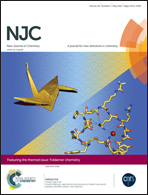Enhanced hydrogen production under a visible light source and dye degradation under natural sunlight using nanostructured doped zinc orthotitanates†
Abstract
The nanostructured Ag and Co doped zinc orthotitanates (ZOT) were synthesized using a combustion method. The structural and optical analysis shows the existence of cubic and tetragonal phases. Morphological study by FESEM reveals the formation of a web like structure along with pot holes by the self-assembly of spherical nanoparticles of ∼50 nm size. Further, TEM investigations reveal diffused and uneven shaped nanoparticles in the range of 10–25 nm. BET surface area measurements show a decrease in surface area due to doping. These ZOTs were employed for photocatalytic dye degradation (Acid Orange-8 and Rhodamine-B) under natural sunlight. The prima facie observations showed Ag@Zn2TiO4 to be an excellent photocatalyst for dye degradation. The kinetics study shows the order of the reaction to be in the range of 1.1–1.41. The ZOTs synthesized have also been used for photocatalytic hydrogen production from H2S under visible light irradiation. It is noteworthy that utmost H2 production (2784 μmol h−1/100 mg) was observed for Ag@Zn2TiO4 which is much higher than that achieved with visible light active photocatalysts reported so far. The dye degradation and hydrogen production from H2S using ZOT are hitherto unattempted. The nanostructured Zn2TiO4 will be a potential visible light active photocatalyst for waste degradation and water splitting.


 Please wait while we load your content...
Please wait while we load your content...